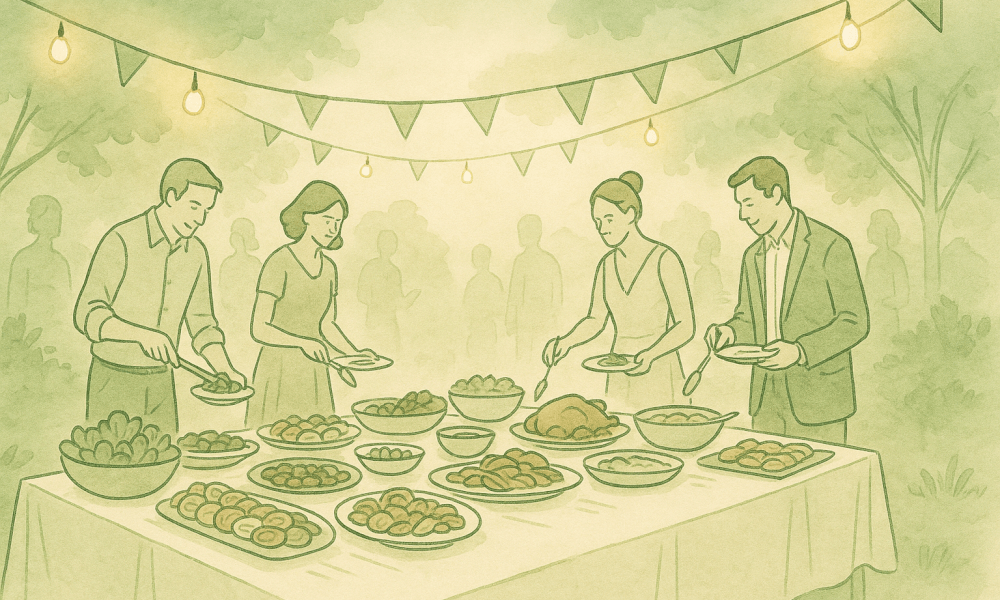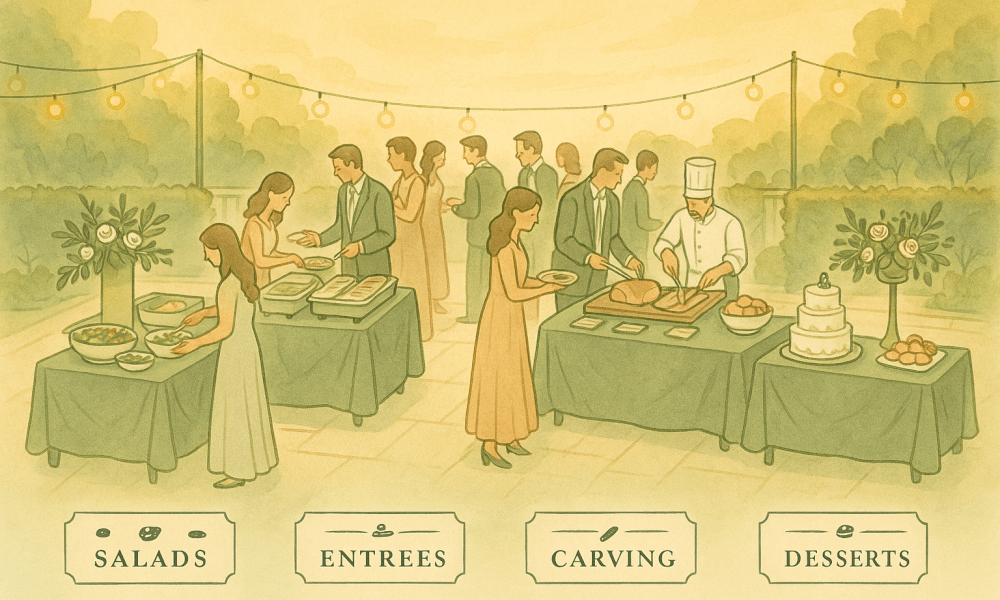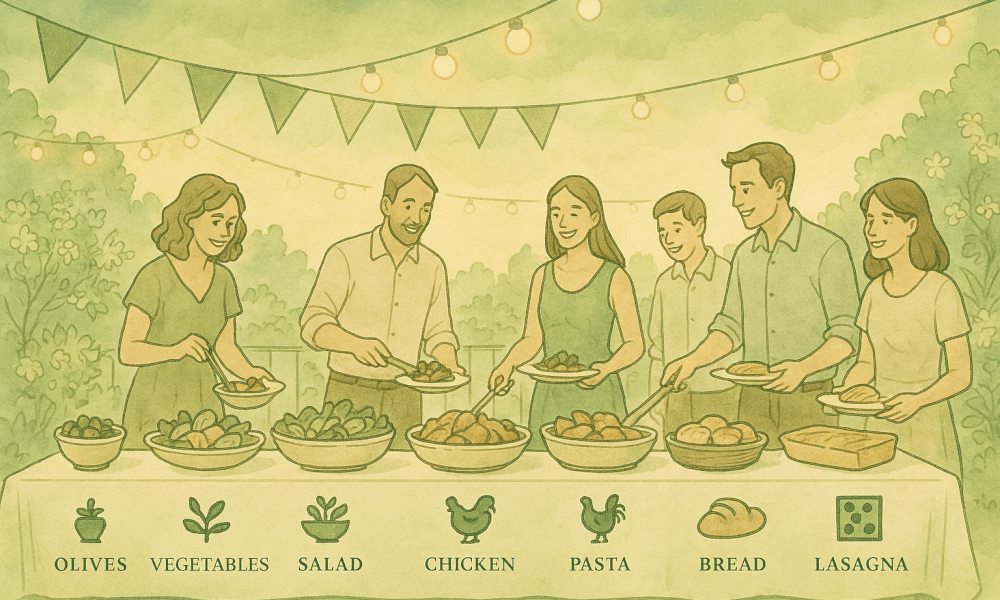Wedding buffet: 4 key steps for a perfect feast

Organizing a wedding buffet requires much more than simply choosing dishes: it’s an art of combining friendliness, indulgence and precise logistics. As a refined and flexible alternative to the traditional plated meal, this format is increasingly appealing to couples seeking a convivial, stylish and tailor-made wedding.
Whether you dream of a rustic banquet in the heart of nature or an elegant indoor reception, creating an unforgettable culinary experience requires careful planning, creative inspiration and the right partners. In this comprehensive guide, discover how to turn your reception into an exceptional moment — from menu selection to the latest trends, plus budget and perfect layout tips.
To structure your thinking from the start, clarify the service format that best suits your reception.
How to organize the perfect wedding buffet?
To set a solid foundation, first compare the options before getting into logistical details.
Advantages and disadvantages of a wedding buffet vs plated service
The choice between a buffet and plated service shapes your entire reception. Advantages of a buffet: lower cost (€70 to €100 per person versus €100 to €150 for plated service), total freedom for guests to portion according to their tastes, a convivial atmosphere that encourages mingling, and less food waste. This wedding buffet format also allows greater flexibility in choosing your caterer. Disadvantages: it can be perceived as less elegant, there can be queues, it’s more complicated to organize for large groups, and the meal can be more fragmented. Advantages of plated service: a refined gastronomic experience with a personalized wedding menu, optimal comfort (guests seated), a controlled pace, and a formal ambience suited to upscale weddings. Disadvantages: higher cost impacting the overall price of the wedding meal, a fixed menu, limited flexibility for special diets, and longer service requiring more staff.
Once you’ve decided on the format, adapt the organization to the number of guests to ensure comfort and smooth flow throughout the service.
Organizing a wedding buffet according to the number of guests
Precisely adapting the buffet to the number of guests ensures smooth operation and satisfaction. For 80 guests, plan for 2 servers, 3 to 4 buffet tables spaced apart, and 20 to 24 kg of food in total including cold and hot buffet items. A wedding of 130 people requires 4 servers, 5 to 6 tables to avoid congestion, and 32 to 39 kg of varied food.
Smaller groups of 30 guests work with a minimum of 2 servers and 1 to 2 tables — ideal for a cold buffet for 50 people by simply scaling down quantities. Each standard table (200 cm x 80 cm) serves 20 to 25 people. Circulation space remains crucial: multiply premium catering service stations to spread flows and always plan for 250 to 300 g of food per person according to your self-service buffet caterer.
The on-site layout then turns your paper plan into a smooth experience for guests.
Logistics and layout of the buffet
The logistical success of the buffet depends on meticulous wedding organization and perfect coordination with your wedding caterer service.

- Plan strategic placement: choose an area with easy circulation for your original wedding buffet, and create distinct zones for starters, hot dishes and desserts.
- Arrange dishes intelligently: place popular items at the beginning of the line for your themed wedding buffet, separate cold from hot, and set up several parallel service points for 100+ guests.
- Ensure multiple access points: create a logical circuit that avoids bottlenecks during the meal, install parallel stations including a culinary animation station, and naturally guide traffic from one side to the other.
- Plan assisted service: position servers to guide guests, quickly refill empty dishes from your wedding kitchen, and keep the buffet area consistently tidy.
- Organize precise timing: coordinate with the caterer on the exact opening time, synchronize delivery and setup according to your meal schedule, and anticipate needs for sufficient crockery and cutlery for your event catering.
The reception venue also requires specific adjustments to preserve the quality of the food and the comfort of your guests.
Tips for outdoor/indoor buffets
Each environment’s specific constraints require targeted adaptations to guarantee the success of your rustic or indoor wedding buffet. An outdoor buffet needs a solid fallback solution (tent or marquee), verified electrical connections for warmers and lighting, and heavy objects to stabilize decorations against the wind. Provide misters or fans depending on the season, mobile sanitary facilities if necessary, and easy access for supplier vehicles delivering meal trays or a wedding brunch.
Indoor settings simplify logistics but require proper ventilation, enough space for circulation for 100+ guests, and coordination with the venue to use kitchen and storage. In all cases, use chalkboards or signs indicating dish contents to manage allergies and special diets, and discuss several wedding buffet ideas with your chosen caterer to determine the optimal buffet pricing for your needs.
Budget and choosing the wedding buffet
Effective planning relies on a clear budget vision and reliable partners at every step.
Estimating the cost of a wedding buffet
The financial question becomes central in wedding planning. A wedding buffet costs between €35 and €100 per person, with prices varying according to the chosen menu and level of service. For 100 guests, plan between €3,500 and €10,000 for your wedding meal. Simple buffets using local products remain around €35–€70, perfect for a rustic wedding buffet.
Gourmet versions reach €90–€100 with a high-end catering service, especially when red meat or refined products are included. The number of guests directly influences the total buffet price. Increase your estimates by 5 to 10% for unforeseen expenses. Don’t forget to include drinks, service staff and equipment rental in your event catering calculations.
Beyond the numbers, the choice of provider determines the quality and peace of mind on your day.
Choosing a caterer: criteria and essential questions
Your caterer choice largely determines the success of the meal. Here are the essential points to check for your wedding buffet caterer:
- Availability and experience: confirm their availability on your date and ask for references from other weddings
- Pre-tasting: insist on tasting the proposed dishes before signing for your wedding menu
- Menu adaptability: check the possibility for personalization and the handling of allergies or specific diets in the catering service
- Knowledge of the venue: favor a caterer familiar with your reception hall
- Pricing transparency: ask for an exact breakdown of services included (service, dishes, setup) for your buffet formula
- Plan B: ask about their policy in case of unexpected staff absences
With a few trade-offs, it’s possible to optimize costs without giving up the pleasure of good food.
Tips for sticking to your budget
Several strategies allow you to control costs without sacrificing the quality of your wedding cuisine. Prefer a buffet to plated service to save up to 50%. Choose buffet ideas with seasonal ingredients, which are cheaper and more flavourful. Vegetarian options reduce costs while diversifying the offer for an original wedding buffet. Limit yourself to three main dishes in your meal planning rather than multiplying choices.

A cocktail reception or culinary entertainment can create a convivial atmosphere for €25–€70 per person. A local self-service caterer is often more affordable. For a cold buffet for 50 people, expect around €1,750 to €3,500. Some elements such as the cake or the next-day brunch can be prepared by relatives. The key is to establish a clear budget from the outset.
The chosen organizational model also affects the logistical burden and the level of calm on the big day.
Homemade buffet vs caterer-provided buffet
This decision greatly influences organization and budget. Homemade is suitable for intimate weddings with a cold buffet of fewer than 50 people. It allows total personalization with your own buffet ideas and substantial savings. However, the logistical burden is heavy: preparation, storage and temperature maintenance for a hot buffet.
Stress can spoil your day. A professional caterer guarantees quality and peace of mind for €35–€100 per person with an appropriate meal tray service. They handle delivery, setup, service and cleanup as part of a personalized themed buffet service. This option is essential for over 50 guests or at a venue without a kitchen. A caterer’s wedding buffet ensures polished presentation and variety that are hard to reproduce on your own.
Which menu to choose for your wedding buffet?
Once the setting is decided, the menu becomes the centerpiece of your reception.
Menu composition becomes central once your budget is set and your caterer selected. A cold wedding buffet is particularly suitable for summer receptions with charcuterie, smoked salmon and assorted terrines — ideal for a cold buffet for 50 people or more. Cold meats such as sliced roast beef pair well with salmon-avocado verrines and tomato gazpacho in this refreshing buffet format.
A hot wedding buffet favors grills, giant paella and gratins for a warm event catering experience. Pan-seared scallops accompany roasted vegetables in this winter catering offering.
The mixed buffet combines cold starters (foie gras, prawns) and hot dishes (barbecue, risottos), offering wedding buffet ideas that cater to different preferences. This flexible organization allows alternating between macarons and molten chocolate cakes depending on the season.
Some dishes remain must-haves in the wedding meal to create a memorable experience, whatever the chosen buffet price.
- Foie gras with fig confit traditionally opens the festivities of a rustic wedding buffet
- Seafood platters (oysters, lobster) bring refinement and freshness to high-end catering
- Herb-roasted suckling pig represents the conviviality of a shared meal in an original wedding buffet
- Fish like monkfish offer a lighter alternative for refined wedding cuisine
- Regional specialties (cassoulet, Lorraine quiches) showcase local terroir in a themed wedding buffet
- Interactive buffets with customizable poke bowls create a modern culinary wedding activity
- The croquembouche tower marks the sweet climax of successful meal planning
Specific diets require special attention when choosing your caterer to satisfy all guests. Vegetable samosas and chickpea-mint falafels satisfy vegetarians and vegans at the wedding brunch or dinner. Lentil patties replace animal proteins in this adaptable self-service catering.

Reimagined Provencal tabbouleh and vegetable wraps diversify the vegetarian wedding meal tray offering. Allergens must be clearly identified on decorative signs to ensure the safety of your inclusive wedding buffet. Gluten-free dishes sit alongside classic options in this modern format. Vegan desserts such as fruit mousses complement traditional pastries, offering accessible buffet pricing while ensuring every guest finds suitable options.
Trends for 2025 are transforming catering into immersive and participatory experiences, completely redefining the traditional concept. The Boho Chic buffet uses wooden boards and handmade tableware for an authentic, natural atmosphere. Poke bowl bars let guests compose their own dishes as part of this interactive animation. Chefs prepare sushi and crepes in front of guests, creating a captivating culinary show.
Mediterranean buffets offer hummus, falafels and grilled vegetables for a sunny touch. Local products and short supply chains favor authenticity in this modern eco-responsible approach. Mini skewers and tasting spoons make elegant and practical tasting easy. Edible flowers create a spectacular floral presentation. These innovations surprise while respecting the tradition of the French wedding meal.
Technical preparation for a successful wedding buffet
Beyond inspiration, success lies in operational details and precise calculations.
How to calculate quantities
Once the wedding menu is defined, calculating quantities precisely ensures all your guests are satisfied without waste during your wedding meal.
- Start with the basic calculation: plan 500 to 600 grams of food per person, including starters, main dishes, sides and desserts. This fundamental rule adapts to the time of day and the length of your reception, and is particularly important for a cold buffet of 50 people or more.
- Detail portions by category: allow 200 grams of meat or fish, 200 grams of vegetables, 100 grams of bread and 120 grams of dessert per guest. For a buffet for 80 people, that represents 16 kilos of meat and an equal amount of vegetables. This wedding meal planning makes the overall organization easier.
- Adjust the number of dishes according to your headcount: offer 2–3 starters, 2 main dishes and 2–3 desserts for 30 to 100 guests. This buffet formula satisfies all tastes without complicating premium catering service.
- Calculate drinks separately: plan one bottle of wine for every 2–3 people, one bottle of champagne for every 4 guests and 0.5 litre of water per guest. A wedding of 100 people requires about 40 bottles of wine and 25 bottles of champagne. These elements directly affect the buffet price and overall catering cost.
- Adjust for specifics: increase quantities by 10% for standing service or a hot buffet, and reduce children’s portions by half. Guests consume more during prolonged events, such as a wedding brunch or an evening catering service.
Decoration and presentation of the buffet
The visual aspect of your rustic or modern wedding buffet directly influences your guests’ experience and deserves special attention in selecting your caterer.
- Structure the space with a large long table covered with a tablecloth that matches your themed wedding buffet, arranging dishes in a logical order that facilitates circulation and service during the event catering.
- Create volume with displays at varying heights: use glass stands, multi-level shelving or cake stands. This technique turns a traditional self-service buffet into a dynamic and elegant installation, perfect for your buffet ideas.
- Match materials to your theme:
- Rustic style: burlap tablecloths, solid wood trays, vintage crockery for an original wedding buffet
- Romantic ambience: lace runners, crystal vases, gold-rimmed plates
- Modern look: mirrors, chrome stands, clear glassware suited to contemporary wedding cuisine
- Integrate immersive background décor with fresh flowers, framed photos of the couple, wall panels or string lights. These elements create an atmosphere consistent with your reception and showcase your caterer’s buffet.
- Personalize with practical details: kraft paper labels to identify dishes, candles in jars for ambience, appropriate tongs and serving spoons. These accessories combine aesthetics and functionality, essential for a successful wedding meal tray.
- Innovate in food presentation: pyramids of colorful fruit, vertical crudité skewers, foie gras macarons, themed food bars (waffle bar, candy bar). These creative presentations form a surprising culinary entertainment that facilitates service while meeting the standards of professional catering.
At heart, the goal remains to offer a generous and smooth experience for everyone.
Choosing the right wedding buffet means skillfully combining culinary pleasure, budget control and logistical harmony. Whether you opt for a rustic, convivial format, a chic and refined buffet or an interactive and modern service, every detail helps elevate your reception. By choosing an experienced caterer, careful presentation and a menu adapted to your guests, you’ll deliver an unforgettable tasting experience. Let go of technical constraints, open the door to creative ideas, and transform your wedding meal into a memorable and festive moment true to your vision.

Weddings


